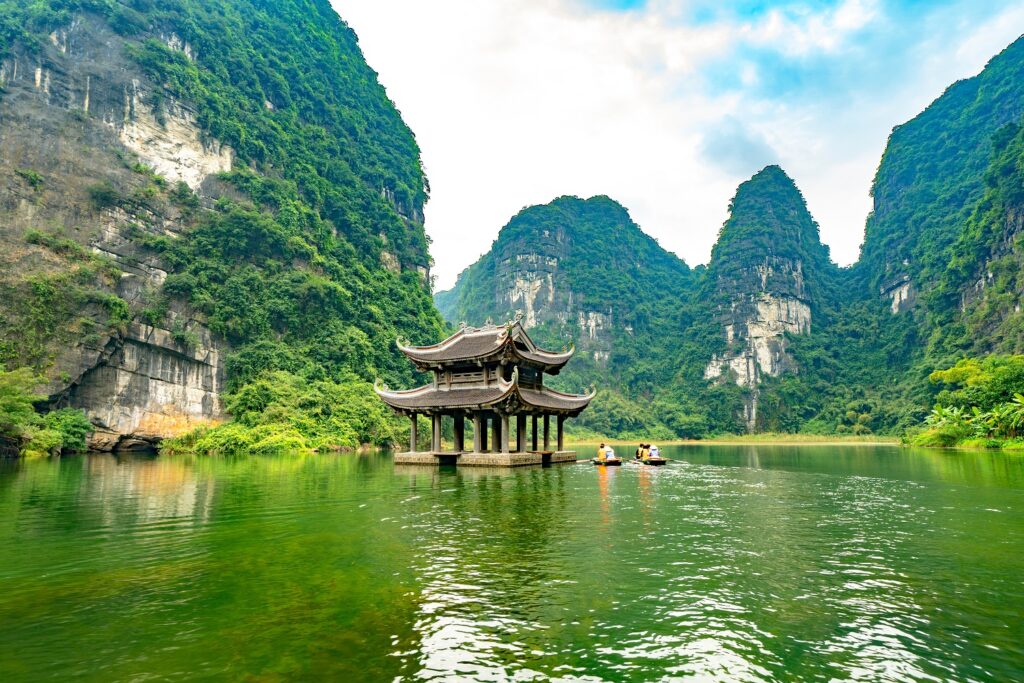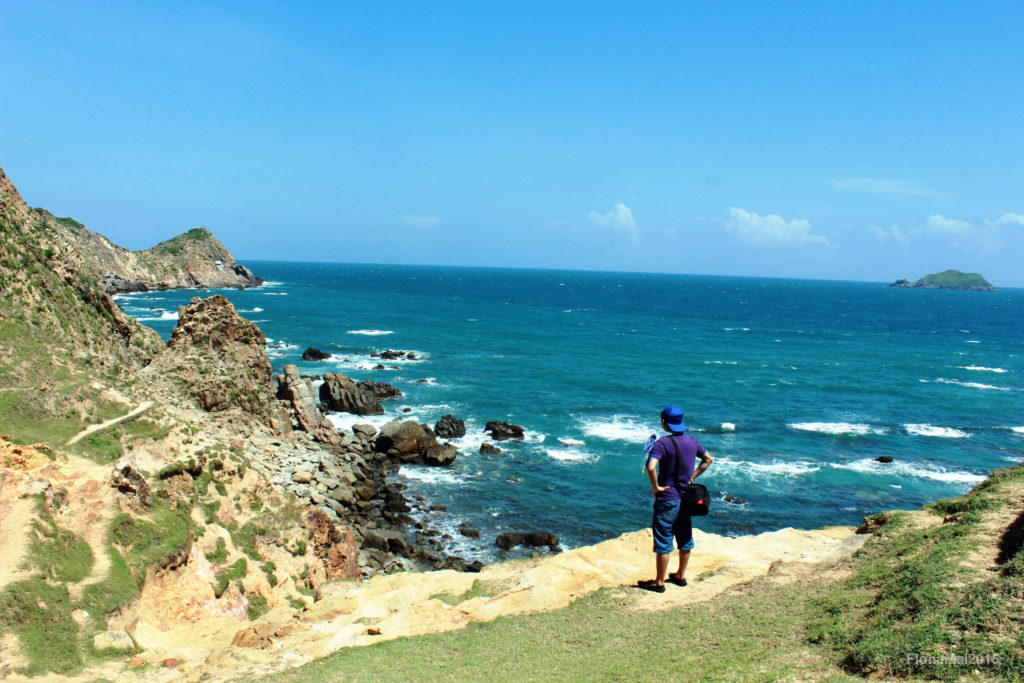As a Vietnamese who has lived in both the north and the south and traveled extensively within the country, I still get hesitant whenever a foreign friend asks “What’s the best time to visit Vietnam?”.
It’s hard to give an affirmative answer to this question because of two reasons. First, the weather in Vietnam varies greatly between its regions. This is partly due to the country’s diverse landscape with mountains, deltas, beaches, islands, valleys, highlands, and so on.

Second, it has recently become more difficult to forecast the weather due to climate change and global warming effects. For example, if you ask any Viet person about the storm season in central Vietnam, almost anyone will claim it starts every year in September. However, the storms have begun to arrive earlier in recent years, sometimes even at the beginning of August!
What’s the best time to visit Vietnam?
What’s the best time to visit Vietnam? As a rule of thumb, it’s best to visit central and southern Vietnam from Dec to Apr when the weather is dry and warm; whereas the north is at its best from Sep to Nov with a mild temperature and occasional light rains.

December – January – February
It’s too cold in the north
How cold is it in northern Vietnam in the winter? The temperature rarely falls below 0, but due to the high humidity, the actual cold feeling is much more intense. Moreover, not everywhere in Vietnam has access to a good heating system. In fact, I’ve lived in northern Europe before and can claim that a -10oC day there still feels more comfortable than a 10oC day in Hanoi.
In January, if you go to Sapa and take the cable car to Fansipan – the highest mountain peak in Vietnam, you can even spot snow. Many Vietnamese people flock here during this time to see snow.
Wintertime is also not an ideal time to take a cruise in Ha Long Bay. There are fewer sunshine hours, and it’s also too cold to swim. For those who plan to take some nice photos in their summer dresses or bikinis on board these cruises, it’s also too cold to do this.
However, if you are still adamant about visiting the north of Vietnam during wintertime, Ta Xua is a destination that I would highly recommend. This is the time when you are most likely to see oceans of clouds on top of Ta Xua mountains – or cloud hunting as the locals call it.

Another great destination to visit in northern Vietnam during this time is Ha Giang – the northernmost province of the country. It’s gonna be very cold up there, but December is the blooming season of buckwheat flowers, which make for amazing scenes.
Best time to visit central and southern Vietnam
Contrary to the cold and unpleasant weather in the north, central and southern Vietnam enjoy their best days from December to February. There is little or no rain at all, making it ideal to go sightseeing outdoors. The sun shines brightly but not harshly, so you can take beautiful photos without sweating too much.
In addition, it’s Tet so you can enjoy the holiday atmosphere here.
Places to visit:
- The seaside cities along the central coast of Vietnam (Da Nang, Hue, Hoi An, Nha Trang, Quy Nhon, Phu Yen, Mui Ne, etc.)
- The central highland (Buon Ma Thuot, Da Lat)
- Phu Quoc Island
- The Mekong Delta (Can Tho, My Tho, Soc Trang, etc.)

March – April
High humidity in the north
Although temperatures in the north tend to rise slightly from March, the high humidity still makes it feel very uncomfortable. Moreover, March and April are called the “nồm” season when you can see molds everywhere and the floors are always wet. That’s why I still personally don’t like traveling to the north during this time.
Head to the central and the south
My advice is still to visit central and southern Vietnam during this period. Hoi An and Da Nang look great in March with very little rain and warm weather overall.

April – May
From April to May, Sapa, Mai Chau, Moc Chau, Ha Giang, and other mountainous regions in the north become ideal places to visit. The weather is less cold now and you can see lots of flowers blooming everywhere you go. Plus, it’s also the mesmerizing water-pouring season on Mu Cang Chai rice terraces from May to the end of June.
However, avoid the public holiday from around 30 April – 1 May if you can. The high number of domestic tourists means airports and train stations become unbearably crowded, and accommodation prices also skyrocket.

May – August
May is the start of the rainy season in almost the whole of Vietnam. Expect to see storms and heavy rains wherever you go, especially in June and July. Flooding can happen quite frequently in big cities such as Hanoi and Saigon. Heavy rains can force Ha Long cruises to cancel as well.
On those summer days when there is no rain, the weather can be super hot. Remember to pack your sunblock and wear appropriate clothes.
If you plan to visit the mountainous regions in the north, don’t forget to check the weather forecast beforehand as the chances of storms and floods are quite high during the summer months.
Ironically, summer is also the high season of tourism for Vietnamese tourists. My tip is to avoid traveling to popular beach destinations (Phu Quoc, Da Nang, Nha Trang, etc.) during the weekend as you’ll find yourself surrounded by huge crowds of Vietnamese tourists, ranging from families with noisy kids to companies taking their employees on summer retreats.

September – November
Best time to visit northern Vietnam
Although rains and storms are still widespread in northern Vietnam until mid-September, the end of September onwards is the best time to visit the north. In particular, Hanoi is beautiful in autumn with mild weather and light sunshine. It’s great to board a Ha Long Bay cruise as well.
Most importantly, the rice terraces in mountainous areas become golden and ready for harvesting, showcasing gorgeous scenes. Don’t forget to visit Mu Cang Chai, Pu Luong, Sapa, and Ha Giang during this time.

Beware of the storms in central Vietnam
The storm season in central Vietnam has started, so be sure to check the weather forecast before heading here. During this time, avoid visiting the central coast, including Hoi An, Da Nang, Nha Trang, Quy Nhon, and Phu Yen.
Acceptable weather in the south
There is still rain in southern Vietnam although with less severity. Phu Quoc Island in particular will be in its best shape from the end of October with warm weather and calm beaches.
It’s also the flood season in the Mekong Delta from August to November, which, surprisingly, provides visitors with amazing travel experiences such as paddling through forests, catching fish, and enjoying specialties unique to this season.
If you plan to travel during this period, avoid scheduling your trip around the 2nd of September. It’s one of Vietnam’s most important public holidays, and you’ll likely have to elbow your way through the crowds at airports and popular tourist attractions.

Summary of the best places in Vietnam to visit each month
- December-April: Head to the central and the south
- April-May: Sapa, Ha Giang, Moc Chau, and other mountainous areas in North Vietnam
- May-August: I can’t highly recommend any particular destination, unfortunately, but you can still try your luck!
- September-November: Best season to visit northern Vietnam
What if you can’t visit Vietnam during its best time?
If you have booked a tour to Vietnam when the weather is not the greatest, there are still some reasons not to panic.
- As I’ve mentioned above, there is no definite guide to the best time to visit Vietnam, so use these pieces of information for reference only. If you’re lucky, your visit can still fall into the rare nice days during the storm seasons.
- Visiting Vietnam during the low season can help you save money. Accommodations and transport will be much cheaper. You will also not have to deal with large groups of other tourists. Ideal for those looking for a peaceful getaway.
Pin this for future reference:




What a comprehensive explanation of when to visit – it can be hard to truly understand the best time to visit Vietnam.
Vietnam is one of my favorite countries in the world! I was lucky enough to spend one month there in December
Thank you for this. I have been thinking of visiting Vietnam and now I know when will be the best time to visit. Thank you.
Thank you so much for this great information. What would you do if you were me- I’m coming to Hanoi on 23rd of November and wanted to spend 3 nights there and after that going up north. do you recommend going straight to the north after landing in Hanoi or do you think i should pass the north and go straight to the south?
Thanks 😃
Hi Elinor, how many days in total do you have in Vietnam?
**Pros of visiting northern Vietnam in late November:
– It’s the buckwheat flower season in Ha Giang and you can take beautiful photos of buckwheat fields there
– Less crowded, especially in Ninh Binh (Tam Coc, Trang An, etc.) –> It’s more likely you’ll enjoy a peaceful trip 🙂
**Cons:
– All rice paddies have been harvested so rice-terraced fields there might not look as lovely as in Sep/Oct.
– It’s already quite cold in the mountainous areas, though still not as cold as in January
– If it’s too cold you might not be able to swim/kayak while going on a Halong Bay cruise
If you love visiting mountainous areas, have no problem with cold weather, prefer visiting less crowded places, and have plenty of time in Vietnam, then it’s ok to spend a few days exploring northern Vietnam more. Otherwise, you can head straight to the south and enjoy the warm weather and beautiful beaches here 🙂